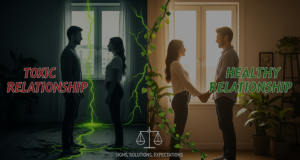When Love Turns Toxic: Can Things Get Better?
You love someone deeply, but lately, your relationship feels like a constant roller coaster. Arguments erupt over small things, trust feels fragile, and emotional pain seems to dominate. You might ask yourself: Can a toxic relationship become healthy, or is this just the reality I have to accept?
Many people remain in toxic relationships, clinging to hope that things will improve. They hope that love alone will heal recurring problems, but transformation requires more than hope it requires awareness, commitment, and actionable change.
This post explores whether a toxic relationship can become healthy, the signs that indicate potential for change, the steps necessary for rebuilding trust, and when it might be best to walk away. If you’ve been questioning the health of your relationship, this guide will provide clarity and practical insight.
Understanding Toxic Relationships
What Makes a Relationship Toxic?
A toxic relationship is characterized by consistent patterns of behaviors that harm emotional, psychological, or even physical well-being. Common features include:
- Emotional abuse: Constant criticism, belittling, or controlling behavior.
- Manipulation: Guilt-tripping, gaslighting, or using fear to control decisions.
- Lack of respect: Disregarding feelings, needs, or boundaries.
- Constant conflict: Frequent fights that escalate without resolution.
Understanding these characteristics is essential, as recognizing toxicity is the first step toward determining whether a relationship can improve.
Types of Toxicity
Toxicity in relationships can manifest in several ways:
- Emotional toxicity: Negativity, criticism, or persistent emotional instability.
- Psychological toxicity: Gaslighting, manipulation, or undermining self-esteem.
- Financial toxicity: Control over money, restricting financial freedom.
- Physical toxicity: Any form of physical harm or threat.
Each type of toxicity impacts the relationship differently and requires tailored strategies for resolution or, in some cases, separation.
Why People Stay in Toxic Relationships
Despite harm, many stay because of:
- Emotional attachment and deep love
- Fear of being alone or societal pressure
- Hope that the partner will change
- Shared responsibilities like children, finances, or living arrangements
Recognizing why you stay is crucial, as it can help clarify whether change is possible or whether it may be healthier to move on.
Signs a Toxic Relationship Might Be Changeable
Can a Toxic Relationship Become Healthy?
Not all toxic relationships are beyond repair. Change is possible if both partners acknowledge the issues and are committed to transformation. Signs that a toxic relationship might become healthy include:
- Mutual acknowledgment of toxicity: Both partners recognize the harm and express a desire to change.
- Open communication is emerging: Even if challenging, honest dialogue is possible.
- Presence of accountability: Both partners take responsibility for their actions and show genuine remorse.
- Occasional positive interactions: Moments of joy, connection, and support indicate potential for a stronger foundation.
Example of Change in Action
Take the story of Lisa and Jordan. They struggled with constant arguing and emotional distance. After acknowledging their toxic patterns, they sought couples counseling, practiced healthy communication, and committed to individual growth. Over time, they rebuilt trust, and their relationship became far healthier than before proving that transformation is achievable with effort and mutual commitment.
Why Some Toxic Relationships Can’t Change
While change is possible in some cases, not all toxic relationships are salvageable. Recognizing when transformation is unrealistic protects emotional and physical well-being.
Red Flags for Irreparable Relationships
- Persistent abuse: Emotional, verbal, or physical abuse continues despite attempts at change.
- Lack of accountability: One partner refuses to acknowledge harmful behaviors.
- Repeated betrayal: Trust is consistently broken with no effort to repair it.
- One-sided effort: Only one partner is committed to improving the relationship.
Supporting Data
Studies suggest that attempts to repair relationships without mutual commitment often fail, with high rates of repeated toxic patterns and emotional distress. Knowing these statistics helps set realistic expectations.
Steps to Transform a Toxic Relationship
For relationships with potential to improve, a structured approach is necessary.
1. Seek Professional Help
Therapy, either couples counseling or individual support, can provide:
- Objective guidance to navigate complex emotions
- Tools for healthier communication and conflict resolution
- Strategies to rebuild trust and intimacy
2. Develop Healthy Communication Strategies
- Set and respect boundaries
- Practice active listening, avoiding judgment or defensiveness
- Use “I” statements to express feelings without blame
3. Build Trust Gradually
- Consistency in actions and words
- Transparency about intentions and feelings
- Small, actionable changes that demonstrate reliability
4. Focus on Self-Care and Personal Growth
Maintaining personal well-being is crucial:
- Maintain independence and hobbies
- Engage in emotional self-care and mindfulness practices
- Build support networks outside the relationship
Managing Expectations and Recognizing Limits
Set Realistic Goals
Transformation is a gradual process that requires:
- Patience and time
- Mutual effort
- Acceptance that progress may be nonlinear
Recognize When Change Isn’t Happening
- Cycles of abuse continue
- Boundaries are ignored
- One partner refuses accountability
- Emotional or physical harm persists
Empower Yourself to Leave if Necessary
Sometimes the healthiest choice is separation. Leaving a toxic relationship can be empowering and may allow both individuals to grow independently and seek healthier connections in the future.
Conclusion — Love, Growth, and Knowing Your Limits
A toxic relationship can sometimes become healthy, but only if both partners acknowledge the issues, commit to change, and actively work on building trust and respect. Signs of potential transformation include accountability, communication, and occasional positive interactions. Yet, persistent abuse, repeated betrayal, or one-sided effort may indicate the relationship cannot improve, making separation the healthier choice.
Ask yourself: Is your love nurturing your growth or holding you back? Honest evaluation is the first step toward clarity and well-being.
If you want to study a part of this, please visit here!
Remember, love should empower you, not diminish your sense of self. Whether you choose transformation or safe separation, prioritizing emotional health is always the right choice.







